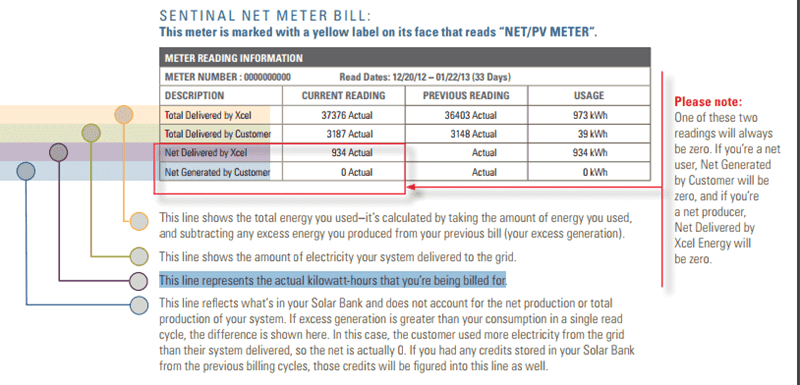How to Read Your Residential Solar Xcel Bill
If you have a residential solar electric system on your roof with Xcel as your utility, you’ve likely had questions. The most common are:
- How does Xcel measure the energy you use and produce?
- How do I know how much energy Xcel is charging me for when my solar isn’t producing?
- How do I know how much energy my system delivered?
Because we help clients with this regularly, I want to preemptively share the FAQs to help with any current or future questions. Of course, we’re always here to help if you have additional questions.
HOW DOES XCEL MEASURE THE ENERGY YOU USE AND PRODUCE?
The amount of solar your system produces and uses will naturally vary throughout the year. For example, you may produce more energy than you use during the summer months, whereas during the winter months the demand for ongoing heat may mean you may use more energy than you produce.
Xcel uses net and production meters to keep track of this seasonal ebb and flow. The net meter moves forward when electricity flows from the Xcel grid into your home, and backward when you’re producing an abundance of energy that flows from your solar electric system onto Xcel’s grid. Each month, Xcel reads the energy flow measures and distinguishes kilowatt-hours (kWh) being taken from the grid (used) and pushing out to the grid (produced). If you produce more electricity than you use, you’re considered a “net producer,” and you won’t have a bill for any kWh during that billing cycle. Any excess kWh are stored in your Solar Bank for future use.
If you use more than you produce, your bill will show the difference (net kWh). The production meter is a standard meter that’s set up for payment of Renewable Energy Credits (RECs) rather than for billing. It’s used to calculate your monthly REC payments.
HOW DO I KNOW HOW MUCH ENERGY XCEL IS CHARGING ME FOR WHEN THE SOLAR ISN’T PRODUCING? HOW DO I KNOW HOW MUCH ENERGY MY SYSTEM DELIVERED?
Your bill has four main categories that demonstrate the energy flow described above:
- Total (kWh) Delivered by Xcel: This line shows the total energy you used from Xcel. It’s calculated by taking the amount of energy you used and subtracting any excess energy you produced from your previous bill (your excess generation). This one can be tricky, so I’ll provide some more details at the end of this article.**
- Total (kWh) Delivered by Customer: This line shows the amount of electricity your system delivered to the grid. The energy delivered to the grid is solar energy going to the grid after first going directly to the loads in the building.
- Net (kWh) Delivered by Xcel: This line represents the actual kilowatt-hours that you are buying from Xcel after calculating what you’ve produced vs. what you’ve used.
- Net (kWh) Generated by customer: This line represents the volume of kWh you have built up if you have not consumed all of these credits already. If your system was designed as a Solar Bank, meaning it will offset 100% or more of your electricity use over the course of the year, you may have these built up in the summer since solar systems tend to produce more in the summer than the winter.
Here is a section of Xcel’s updated “How to read Xcel Bill” Document:

**Total Delivered by Xcel—Detailed Explanation:
The first line in the image above is the most important because it explains that the “Total Delivered by Xcel” a.k.a. the volume of kWhs delivered after counting the solar kWh production excess from the month before—if there is any excess.
This is why it looks like only X% of what you’re getting credit for.
The line “Total Delivered by the Customer” is what most frequently confuses people. And it is confusing! This metric makes it sounds like it’s counting all of the energy from your system, but it’s not. Rather, this metric is just the energy that made it to the grid. In other words, the “Total Delivered by Xcel” shows the amount of energy delivered to the grid after the solar delivered X% of the kWh directly to the loads in the building.
